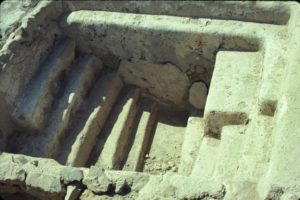Discovering What Jewish Miqva’ot Can Tell Us About Christian Baptism, William Sanford La Sor, Biblical Archaeology Review (13:1), Jan/Feb 1987.
Until the discoveries of modern archaeology, we knew about ancient Jewish ritual immersion baths only from literary texts. Now, however, archaeology has provided us with numerous examples of Jewish ritual immersion baths, called miqva’ot (singular, miqveh), dating to the late Second Temple period, prior to and during the time when John the Baptist lived. These miqva’ot undoubtedly provide the background for Christian baptism. But many questions concerning the precise relationship are nevertheless likely to remain unanswered.
The first ancient miqva’ot to be identified as such were found by Yigael Yadin in the early 1960s at Masada, Herod’s mountain fortress in the Judean wilderness. Masada later served as the last stronghold of the Jews in the revolt against Rome that culminated in the Roman destruction of Jerusalem in 10 A.D. The 960 defenders of Masada held out for three years after Jerusalem fell.
Archaeologist Yadin describes the excitement at the discovery of two miqva’ot at Masada,1 especially among talmudic scholars; they carefully measured the first one when it was unearthed in order to ascertain whether it conformed to the requirements of talmudic law, in other words if it was a genuine miqveh. The Masada miqveh passed the test.
Read the rest of Discovering What Jewish Miqva’ot Can Tell Us About Christian Baptism in the online Biblical Archaeology Society Library.




